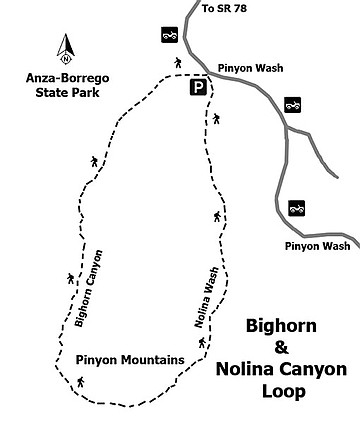 Facebook
Facebook
 X
X
 Instagram
Instagram
 TikTok
TikTok
 Youtube
Youtube

This Anza-Borrego desert hike takes an adventure through lightly visited canyons where one may encounter a bighorn sheep, view some fascinating rock formations, and find an array of wildflowers if the rains have cooperated. It is also interesting to compare these two canyons and their washes. While similar, they also have their differences. Ironwood trees are relatively rare in Bighorn Wash but common in Nolina Wash, and the yucca relative, nolina, appears to be confined to Nolina Wash. One of the ways that nolina differs from yucca is in having pliant fibrous leaves unlike the stiff leaves associated with the yucca.
Although the route is obvious, for most of the distance there is no maintained trail, and some boulder-hopping is necessary. From your parked vehicle at the junction of the Pinyon Wash jeep trail and the Nolina jeep trail, start hiking west across the flat, sandy Mescal Bajada. About 0.3 mile from your vehicle, begin tending southwest and continue until Bighorn Canyon is visible ahead, which you will enter after covering about 1 mile. The canyon gradually narrows as you hike south through scattered catclaw acacia, rabbitbrush, agave, barrel and fishhook cactus, two kinds of cholla, Mormon tea, and occasional juniper trees. Blue Spring, on the north-facing slope of Pinyon Mountain, is 3.75 miles from your vehicle, if you choose to go there. It was developed as a guzzler for the Pinyon Mountain bighorn sheep and is not a source of water for humans. The best chance for seeing the elusive sheep requires remaining quiet and carefully scanning the steep rocky slopes above the spring or near some of their favorite forage plants: catclaw, encelia, sweetbush, and krameria. Their efficient digestive system allows them to maximize removal of nutrients from what can be well-armed dry and abrasive plants.

If you do go to the Blue Spring, reverse your steps until the low pass to the east that separates Bighorn and Nolina canyons is visible. Then go toward it, following the ducks that lead over the pass and down into Nolina Canyon. Take care making your way down-canyon, where you must negotiate some short, dry falls. The Nolina Canyon jeep trail is 1.75 miles from the pass summit. Scrambling over rocks ends here and hiking becomes easy again. Just follow the jeep trail through soft sand back to your vehicle.
Be prepared with at least a liter of water and check temperatures for all hikes for optimum time for comfort level.


This Anza-Borrego desert hike takes an adventure through lightly visited canyons where one may encounter a bighorn sheep, view some fascinating rock formations, and find an array of wildflowers if the rains have cooperated. It is also interesting to compare these two canyons and their washes. While similar, they also have their differences. Ironwood trees are relatively rare in Bighorn Wash but common in Nolina Wash, and the yucca relative, nolina, appears to be confined to Nolina Wash. One of the ways that nolina differs from yucca is in having pliant fibrous leaves unlike the stiff leaves associated with the yucca.
Although the route is obvious, for most of the distance there is no maintained trail, and some boulder-hopping is necessary. From your parked vehicle at the junction of the Pinyon Wash jeep trail and the Nolina jeep trail, start hiking west across the flat, sandy Mescal Bajada. About 0.3 mile from your vehicle, begin tending southwest and continue until Bighorn Canyon is visible ahead, which you will enter after covering about 1 mile. The canyon gradually narrows as you hike south through scattered catclaw acacia, rabbitbrush, agave, barrel and fishhook cactus, two kinds of cholla, Mormon tea, and occasional juniper trees. Blue Spring, on the north-facing slope of Pinyon Mountain, is 3.75 miles from your vehicle, if you choose to go there. It was developed as a guzzler for the Pinyon Mountain bighorn sheep and is not a source of water for humans. The best chance for seeing the elusive sheep requires remaining quiet and carefully scanning the steep rocky slopes above the spring or near some of their favorite forage plants: catclaw, encelia, sweetbush, and krameria. Their efficient digestive system allows them to maximize removal of nutrients from what can be well-armed dry and abrasive plants.

If you do go to the Blue Spring, reverse your steps until the low pass to the east that separates Bighorn and Nolina canyons is visible. Then go toward it, following the ducks that lead over the pass and down into Nolina Canyon. Take care making your way down-canyon, where you must negotiate some short, dry falls. The Nolina Canyon jeep trail is 1.75 miles from the pass summit. Scrambling over rocks ends here and hiking becomes easy again. Just follow the jeep trail through soft sand back to your vehicle.
Be prepared with at least a liter of water and check temperatures for all hikes for optimum time for comfort level.